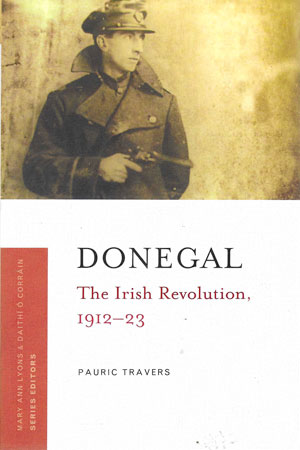DONEGAL: THE IRISH REVOLUTION 1912–1923
Published in Book Reviews, Book Reviews, Issue 6 (November/December 2022), Reviews, Volume 30PAURIC TRAVERS
Four Courts Press
€22.45
ISBN 9781846829789
Reviewed by John Dorney
John Dorney is the editor of ‘The Irish Story’ website.
Pauric Travers’s study of Donegal during the years of upheaval from 1912 to 1923 plots a course from a politics dominated before the Great War by the Irish Parliamentary Party (IPP) and the remaining patrician unionist elements to one overtaken in 1917–18 by the separatist Sinn Féin party. Despite sometimes violent opposition from the Ancient Order of Hibernians and the ‘awarding’ of East Donegal to the IPP by the Catholic bishops, Sinn Féin rapidly overtook the Redmondites and trounced them in the general election of 1918. The declining enthusiasm for the war and the postponement of Home Rule, combined with conscription, helped to sink the IPP and cleared the way for the political/military republican campaign of 1919–21. This is, so far, a very similar pattern to that in other counties.
Where Donegal was different, as this book stresses, was in its unique geographical and sectarian situation. In Donegal’s case it was dismay at the prospect of partition that largely drove the eclipse of Home Rule nationalism. East Donegal was substantially Protestant and unionist and also, for different reasons, very hostile to partition. Over 17,000 men and women there signed the 1912 Covenant or Declaration to resist Home Rule and large numbers of men joined the Ulster Volunteer Force (UVF), led by local grandee Lord Leitrim. This community ended up abandoned by their co-religionists across the new border from 1920 onwards—cast aside, as they complained, as the price for a more homogeneous Protestant and unionist state in Northern Ireland.
Whereas the Home Rule crisis of 1912–14 appeared particularly menacing in Donegal, with rival Volunteers apparently ready to come to blows, a somewhat surprising aspect of the War of Independence (1919–21) was that Donegal unionists played very little part as a counter-revolutionary force. While some joined the Ulster Special Constabulary, the pre-war UVF was notably quiet in Donegal.
The stories of two O’Donnells run throughout. One was Patrick, a Catholic bishop and a nationalist, but one who condemned violence. He played an important role in the Irish Convention of 1917, in which he argued for fiscal autonomy for Home Rule Ireland and against partition. His influence waned, however, after the Sinn Féin electoral victory of 1918 and, though he privately disagreed with the Free State’s policy of executions, his residence was burned in reprisal for the executions of four republicans at Drumboe in March 1923.
The other was Peadar, a left-wing republican who emerged first as a trade union organiser and later as an IRA commander in Donegal. Although described by Travers as an eccentric soldier, often unwilling to take orders, he also became one of the main participants and later chroniclers of the IRA campaign in Donegal.
Peadar O’Donnell described the War of Independence as a ‘sham war’ in that the military side was far less important than the seizure of political power and the wielding of a ‘counter-state’ by the republicans. Travers concurs and has some perceptive things to say about the violence of that period. Local power was wielded ‘ruthlessly’ by Sinn Féin, he writes, and the IRA’s enforcement of a boycott on the Royal Irish Constabulary (RIC) was often brutally enforced. He cites several cases of women who were beaten and had their hair shorn for cooperating with the RIC.
The Dáil Courts were also established early there and functioned in some cases into 1922. And while fatalities in County Donegal were fairly low (29 killed for 1919–21), Travers shows that non-lethal activity was very high, with the rates of ‘indictable crime’ rising from a mere seven per month in 1919 to 70–80 per month in late 1920 and early 1921. Most of these consisted of road destruction, arms raids and the burning of buildings, demonstrating, Travers concludes, a high level of popular mobilisation.
By contrast, the Civil War period (1922–3) saw comparable fatalities (26 killed) but, Travers muses, less mobilisation. Donegal was largely pro-Treaty in sympathy. Peadar O’Donnell had been arrested in Dublin at the Four Courts and the anti-Treaty IRA in the county, notwithstanding the presence of local republicans such as Eithne Coyle, was dominated by Cork and Kerry men who had earlier been sent to the border area for an anticipated ‘Northern offensive’. That campaign fizzled out after a large-scale encounter at the border villages of Belleek and Pettigo in June 1922 between Crown forces, including regular British troops equipped with artillery, and pro- and anti-Treaty IRA.
There followed a low-level internecine war between pro- and anti-Treaty elements, book-ended by the executions of four anti-Treatyites at Drumboe in March 1923. Most anti-Treaty forces evacuated the county in October 1922 by boat. Peadar O’Donnell was, we learn, taken from the Curragh to Donegal as a hostage against further anti-Treaty attacks.
One might have expected that Donegal, about 35% Irish-speaking and beset by rural poverty, would be fertile ground for republican social revolution, as Peadar O’Donnell had hoped. Travers argues, however, that such poverty actually made an IRA campaign almost impossible to sustain there. Many, Travers concludes, in Donegal, both nationalist and unionist, were disappointed with the results of independence, both because partition cut the county off from its natural hinterland in what became Northern Ireland and because its pattern of underdevelopment and emigration continued. This is an engaging summary of events in Donegal in those years and a good addition to the series.

















